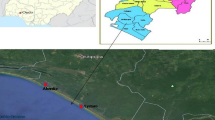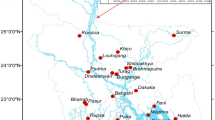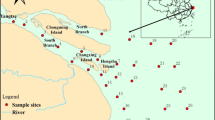Abstract
Concentrations of heavy metals in water and sediment samples of Buriganga River in the capital city Dhaka, Bangladesh, were studied to understand the level of heavy metals and their source apportionment. The results showed that the mean concentrations of heavy metals both in water and sediment samples were very high and, in most cases, exceeded the permissible limits recommended by the Bangladesh government and other international organizations. Significantly higher concentrations of Pb, Cr, Mn, Co, Ni, Cu, Zn, As, and Cd were found in sediment samples. However, average concentrations of metals both in water and sediment samples were above the effect range median. The heavy metal pollution index (HPI) and degree of contamination (C d) yielded different results in water samples despite significant correlations between them. The heavy metal evaluation index (HEI) showed strong correlations with HPI and C d and provided better assessment of pollution levels. The enrichment factor (EF) and geoaccumulation index (I geo) showed the elevated value of Cr, Pb, and Cd in access of background values. The measured elements were subjected to positive matrix factorization (PMF) and examining correlations in order to explain the content, behavior, and source apportionment of metals. PMF resulted in a successful partitioning of variances into sources related to background geochemistry and contaminant influences. However, the PMF approach successfully demarcated the major sources of metals from tannery, paint, municipal sewage, textiles, and agricultural activities.





Similar content being viewed by others
References
Ahmad, J. U., & Goni, M. A. (2010). Heavy metal contamination in water, soil, and vegetables of the industrial areas in Dhaka, Bangladesh. Environmental Monitoring and Assessment, 166, 347–357. doi:10.1007/s10661-009-1006-6.
Ahmad, M. K., Islam, S., Rahman, S., Haque, M. R., & Islam, M. M. (2010). The spatial and temporal distribution of heavy metals in water, sediment and fish (dry weight basis) of Buriganga River, Bangladesh. International Journal of Environmental Research, 4, 321–332.
Anttila, P., Paatero, P., Tapper, U., & Jarvinen, O. (1995). Source identification of bulk wet deposition in Finland by positive matrix factorization. Atmospheric Environment, 29, 1705–1718.
APHA (American Public Health Association) (1995). Standard methods for the examination of water and wastewater (19th ed.). Washington.
Backman, B., Bodis, D., Lahermo, P., Rapant, S., & Tarvainen, T. (1997). Application of a groundwater contamination index in Finland and Slovakia. Environmental Geology, 36, 55–64.
Bhuiyan, M. A. H., Suruvi, N. I., Dampare, S. B., Islam, M. A., Quraishi, S. B., Ganyaglo, S., & Suzuki, S. (2011). Investigation of the possible sources of heavy metal contamination in lagoon and canal water in the tannery industrial area in Dhaka, Bangladesh. Environmental Monitoring and Assessment, 175, 633–649.
Bhuiyan, M. A. H., Islam, M. A., Dampare, S. B., Parvez, L., & Suzuki, S. (2010). Evaluation of hazardous metal pollution in irrigation and drinking water systems in the vicinity of a coal mine area of northwestern Bangladesh. Journal of Hazardous Materials, 179, 1065–1077.
Boamponsem, L. K., Adam, J. I., Dampare, S. B., Nyarko, B. J. B., & Essumang, D. K. (2010). Assessment of atmospheric heavy metal deposition in the Tarkwa gold mining area of Ghana using epiphytic lichens. Nuclear Instruments and Methods in Physics Research B, 268, 1492–1501.
Bzdusek, P. A., Lu, J., & Christensen, E. R. (2006). PCB congeners and dechlorination in sediments of Sheboygan River, Wisconsin, determined by matrix factorization. Environmental Science and Technology, 40, 120–129.
Cabrera, F., Clemente, L., Barrientos, E. D., Lόpez, R., & Murillo, J. M. (1999). Heavy metal pollution of soils affected by the Guadiamar toxic flood. Science of the Total Environment, 242, 117–129.
Çevik, F., Göksu, M. Z. L., Derici, O. B., & Fındık, Ö. (2009). An assessment of metal pollution in surface sediments of Seyhan dam by using enrichment factor, geoaccumulation index and statistical analyses. Environmental Monitoring and Assessment, 152, 309–317.
Chatterjee, M., Silva Filho, E. V., Sarkar, S. K., Sella, S. M., Bhattacharya, A., Satpathy, K. K., Prasad, M. V. R., Chakraborty, S., & Bhattacharya, B. D. (2007). Environment International, 33, 346–356.
Chen, C.-W., Kao, C.-M., Chen, C.-F., & Dong, C.-D. (2007). Distribution and accumulation of heavy metals in the sediments of Kaohsiung Harbor, Taiwan. Chemosphere, 66, 1431–1440.
Comero, S., Servida, D., De Capitani, L., & Gawlik, B. M. (2012). Geochemical characterization of an abandoned mine site: a combined positive matrix factorization and GIS approach compared with principal component analysis. Journal of Geochemical Exploration, 118, 30–37.
Cook, J. A., Andrew, S. M., & Johnson, M. S. (1990). Lead, zinc, cadmium and fluoride in small mammals from contaminated grassland established on fluorspar tailings. Water, Air, and Soil Pollution, 51, 43–54.
Delbert, J. E., Grover, B. D., Woolwine, W. R., Eatough, N. L., Prather, K. A., Shields, L., Qin, X., Denkenberger, K., Long, R., & Farber, R. (2008). Source apportionment of 1 h semicontinuous data during the 2005 Study of Organic Aerosols in Riverside (SOAR) using positive matrix factorization. Atmospheric Environment, 42, 2706–2719.
Denton, G.R.W., Wood, H.R., Concepcion, L.P., Siegrist, H.G., Eflin, V.S., Narcis, D.K., Pangelinan, G.T. (1997). Analysis of in-place contaminants in marine sediments from four harbor locations on Guam: a pilot study. Mangilao: Water and Environmental Research Institute of the Western Pacific, Technical Report No. 87, University of Guam
Edet, A. E., & Offiong, O. E. (2002). Evaluation of water quality pollution indices for heavy metal contamination monitoring. A study case from Akpabuyo-Odukpani area, Lower Cross River Basin (southeastern Nigeria). GeoJournal, 5, 295–304.
EPA (1998). Locating and estimating air emissions from sources of arsenic and arsenic compounds. Office of air quality, planning and standards research triangle Park, NC 27711
Espen, P. V., Nullens, H., & Adams, F. (1977). A computer analysis of X-ray fluorescence spectra. Nuclear Instruments and Methods, 142, 243–250.
FAO (1972). Overall study of the Messara Plain. Report on study of the water resources and their exploitation for irrigation in eastern Crete, FAO Report No. AGL:SF/GRE/31
Ghrefat, H., & Yusuf, N. (2006). Assessing Mn, Fe, Cu, Zn and Cd pollution in bottom sediments of Wadi Al-Arab Dam, Jordan. Chemosphere, 65, 2114–2121.
Gibbs, R. J. (1973). Mechanisms of trace metal transport in rivers. Science, 180, 71–72.
Gonzáles-Macías, C., Schifter, I., Lluch-Cota, D. B., Méndez-Rodríguez, L., & Hernández-Vázquez, S. (2006). Distribution, enrichment and accumulation of heavy metals in coastal sediments of Salina Cruz Bay, Mexico. Environmental Monitoring and Assessment, 118, 211–230.
González-Macías, C., Sánchez-Reyna, G., Salazar-Coria, L., & Schifter, I. (2014). Application of the positive matrix factorization approach to identify heavy metal sources in sediments. A case study on the Mexican Pacific Coast. Environmental Monitoring and Assessment, 186, 307–324. doi:10.1007/s10661-013-3375-0.
Han, Y. M., Du, P. X., Cao, J. J., & Posmentier, E. S. (2006). Multivariate analysis of heavy metal contamination in urban dusts of Xi’an, Central China. Science of the Total Environment, 355, 176–186.
Huang, S., Arimoto, R., & Rahn, K. A. (2001). Sources and source variations for aerosol at Mace Head, Ireland. Atmospheric Environment, 35, 1421–1437.
Huang, S., & Conte, M. H. (2009). Source/process apportionment of major and trace elements in sinking particles in the Sargasso Sea. Geochimica et Cosmo chimica Acta, 73, 65–90.
Huang, S., Rahn, K. A., Arimoto, R., Graustein, W. C., & Turekian, K. K. (1999a). Semiannual cycles of pollution at Bermuda. Journal of Geophysical Research, 104, 309–318.
Huang, S., Rahn, K. A., & Arimoto, R. (1999b). Testing and optimizing two factor-analysis techniques on aerosol at Narragansett, Rhode Island. Atmospheric Environment, 33, 2169–2185.
Islam, G. M. R., Khan, F. E., Hoque, M. M., & Jolly, Y. N. (2014). Consumption of unsafe food in the adjacent area of Hazaribag tannery campus and Buriganga River embankments of Bangladesh: heavy metal contamination. Environmental Monitoring and Assessment, 186, 7233–7244.
Jaeckels, J. M., Bae, M. S., & Schauer, J. J. (2007). Positive matrix factorization (PMF) analysis of molecular marker measurements to quantify the sources of organic aerosols. Environmental Science and Technology, 41, 5763–5769.
Jain, C. K., Singhal, D. C., & Sharma, M. K. (2005). Metal pollution assessment of sediment and water in the river Hindon, India. Environmental Monitoring and Assessment, 105, 193–207.
Jiang, D. Z., Teng, E. J., & Liu, Y. L. (1996). The contribution of difference on the element background values in soils and the analysis of variance of single factor on soil groups. Environmental Monitoring China, 2, 21–24.
Karlsson, J., Ytreberg, E., & Eklund, B. (2010). Toxicity of antifouling paints for use on ships and leisure boats to non-target organisms representing three trophic levels. Environmental Pollution, 158, 681–687.
Kaushik, A., Kansal, A., Santosh, M., Kumari, S., & Kaushik, C. P. (2009). Heavy metal contamination of river Yamuna, Haryana, India: assessment by metal enrichment factor of the sediments. Journal of Hazardous Materials, 164, 265–270.
Kim, E., Hopke, P. K., & Edgerton, E. S. (2004). Improving source identification of Atlanta aerosol using temperature resolved carbon fraction in positive matrix factorization. Atmospheric Environment, 38, 3349–3362.
Lee, J. H., & Hopke, P. K. (2006). Apportioning sources of PM2.5 in St. Louis, MO using speciation trends network data. Atmospheric Environment, 40, 360–377.
Michael, J. T. (1975). Water analysis. In F. J. Welcher (Ed.), Standard methods of chemical analysis (part B) (6th ed.). Huntington: Robert E. Krieger Publishing Co. Inc.
Mohan, S. V., Nithila, P., & Reddy, S. J. (1996). Estimation of heavy metal in drinking water and development of heavy metal pollution index. Journal of Environmental Science and Health A, 31, 283–289.
Moniruzzaman, M., Saha, B., & Shahariar, M. S. (2012). Seasonal variations in the water of Buriganga River with respect to heavy metals contamination. Bangladesh Journal of Scientific and Industrial Research, 47, 9–18.
Mousavi, S. R., Balali-Mood, M., Riahi-Zanjani, B., Yousefzadeh, H., & Sadeghi, M. (2013). Concentrations of mercury, lead, chromium, cadmium, arsenic and aluminum in irrigation water wells and wastewater used for agriculture in Mashhad, northeastern Iran. International Journal Occupational Medicine and Environmental, 4, 80–86.
Müller, G. (1979). Schwermetalle in den sediments des Rheins-Veranderungen seitt 1971. Umschan, 79, 778–783.
Müller, G. (1981). Die Schwermetallbelstung der sedimente des Neckars und seiner Nebenflusse: eine Bestandsaufnahme. Chem. Zeitung, 105, 157–164.
Mwamburi, J. (2003). Variations in trace metal levels in sediment and five fish species from lakes in Tokat, Turkey. Food Chemistry, 101, 739–745.
Nolting, R. F., Ramkema, A., & Everaarts, J. M. (1999). The geochemistry of Cu, Cd, Zn, Ni and Pb in sediment cores from the continental slope of Banc d’ Arquin (Mauritania). Continental Shelf Research, 19, 665–91.
Paatero, P. (1996). Least squares formulation of robust non-negative factor analysis. Chemometrics and Intelligent Laboratory Systems, 21, 1–13.
Paatero, P. (1997). Least squares formulation of robust nonnegative factor analysis. Chemometrics and Intelligent Laboratory Systems, 37, 15.
Paatero, P. (2007). User’s guide for positive matrix factorization programs PMF2 and PMF3, part 1‒2: tutorial. Helsinki, Finland: University of Helsinki.
Paatero, P., & Hopke, P. K. (2003). Discarding or downweighting high-noise variables in factor analytic models. Analytica Chimica Acta, 490, 277–289.
Paatero, P., & Tapper, U. (1993). Analysis of different modes of factor analysis as least squares fit problems. Chemometrics and Intelligent Laboratory Systems, 18, 183–194.
Paatero, P., & Tapper, U. (1994). Positive matrix factorization: a non-negative factor model with optimal utilization of error estimates of data values. Environmetrics, 5, 111.
Polissar, A. V., Hopke, P. K., Paatero, P., Malm, W. C., & Sisler, J. F. (1998). Atmospheric aerosol over Alaska 1. Elemental composition and sources. Journal of Geophysical Research, 103, 19045–19057.
Polissar, A. V., Hopke, P. K., & Poirot, R. L. (2001). Atmospheric aerosol over Vermont: chemical composition and sources. Environmental Science and Technology, 35, 4604–4621.
Prasad, B., & Bose, J. M. (2001). Evaluation of the heavy metal pollution index for surface and spring water near a limestone mining area of the lower Himalayas. Environmental Geology, 41, 183–188.
Prasad, B., & Jaiprakas, K. C. (1999). Evaluation of heavy metals in ground water near mining area and development of heavy metal pollution index. Journal of Environmental Science and Health, A34, 91–102.
Rahman, S., Khan, M. T. R., Akib, S., & Biswas, S. K. (2013). Investigation of heavy metal pollution in peripheral river water around Dhaka City. Pensee Journal, 75, 421–435.
Ramessur, R. T., Parry, S. J., & Ramjeawon, T. (2001). The relationship of dissolved Pb to some dissolved trace metals (Al, Cr, Mn and Zn) and to dissolved nitrate and phosphate in a freshwater aquatic system in Mauritius. Environmental International, 26, 223–230.
Rubio, B., Nombela, M. A., & Vilas, F. (2000). Geochemistry of major and trace elements in sediments of the Ria de Vigo (NW Spain): an assessment of metal pollution. Marine Pollution Bulletin, 11, 968–980.
Siegel, F. R. (2002). Environmental geochemistry of potential toxic metals. Berlin Heidelberg New York: Springer.
Sin, S. N., Chua, H., Lo, W., & Ng, L. M. (2001). Assessment of heavy metal cations in sediments of Shing Mun River, Hong Kong. Environment International, 26, 297–301.
Song, X., Polissar, A. V., & Hopke, P. K. (2001). Sources of fine particle composition in the northeastern US. Atmospheric Environment, 35, 52–77.
Soonthornnonda, P., & Christensen, E. R. (2008). Source apportionment of pollutants and flows of combined sewer wastewater. Water Research, 42, 1989–1998.
Suthar, S., Nema, A. K., Chabukdhara, M., & Gupta, S. K. (2009). Assessment of metals in water and sediments of Hindon River, India: impact of industrial and urban discharges. Journal of Hazardous Materials, 171, 1088–1095.
Tariq, S. R., Shaheen, N., Khalique, A., & Sha, M. H. (2010). Distribution, correlation, and source apportionment of selected metals in tannery effluents, related soils, and groundwater—a case study from Multan, Pakistan. Environmental Monitoring and Assessment, 166, 303–312. doi:10.1007/s10661-009-1003-9.
Taylor, S. R. (1964). Abundance of chemical elements in the continental crust: a new table. Geochimica et Cosmochimica Acta, 28, 1273–1285.
Usero, J., Garcia, A., Fraidias, J. (2000). Calidad de las aguas y sedimentos del Litoral Andaluz. Editorial. Junta de Andalicia. Consejeria del Medio Ambiente, Sevilla 164 pp
Vaccaro, S., Sobiecka, E., Contini, S., Locoro, G., Free, G., & Gawlik, B. M. (2007). The application of positive matrix factorization in the analysis, characterisation and detection of contaminated soils. Chemosphere, 69, 1055–1063.
Yaqin, J. I., Yinchang, F., Jianhui, W. U., Tan, Z., Zhipeng, B., & Chiqing, D. (2008). Using geoaccumulation index to study source profiles of soil dust in China. Journal of Environmental Science, 20, 571–578.
Yue, W., Stölzel, M., Cyrys, J., Pitz, M., Heinrich, J., Kreyling, W. G., Wichmann, H.‒. E., Peters, A., Wang, S., & Hopke, P. K. (2008). Source apportionment of ambient fine particle size distribution using positive matrix factorization in Erfurt, Germany. Science of the Total Environment, 398, 133–144.
Acknowledgments
The first author acknowledged the financial support from the Japanese Government (MONBUKAGAKUSHO Scholarship 2010). Sincere gratitude is due to the Department of Earth Sciences, Okayama University, Japan, and the Bangladesh Atomic Energy Commission, Dhaka office, for their technical supports and laboratory facilities.
Author information
Authors and Affiliations
Corresponding author
Rights and permissions
About this article
Cite this article
Bhuiyan, M.A.H., Dampare, S.B., Islam, M.A. et al. Source apportionment and pollution evaluation of heavy metals in water and sediments of Buriganga River, Bangladesh, using multivariate analysis and pollution evaluation indices. Environ Monit Assess 187, 4075 (2015). https://doi.org/10.1007/s10661-014-4075-0
Received:
Accepted:
Published:
DOI: https://doi.org/10.1007/s10661-014-4075-0




